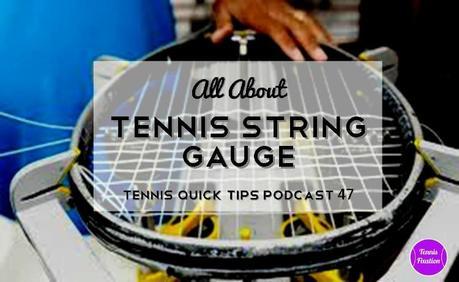Podcast: Play in new window | Download
Just when you think you’ve heard everything there is to hear about tennis strings, it turns out there’s even more. In this episode of Tennis Quick Tips, you’ll find out about tennis string gauge, what it is and how to pick the one that’s right for you. You can listen to this episode by clicking on the media player above or by listening in with your favorite podcast app. You can also subscribe in iTunes by clicking on this link: tennisfixation.com/itunes.

SHOW NOTES:
I bet that, just like me, you’re always looking for any competitive advantage you can get in your tennis matches. And one of those advantages is using the equipment that’s best for your style of play. And probably the most important piece of equipment you have when you’re on the court is your tennis racquet. And the one thing you can easily customize on your racquet are your strings.
So in Episode 13 of Tennis Quick Tips, we talked about the various kinds of tennis string there are out there, the materials they’re made out of, and what kind might be right for you. And in Tennis Quick Tips Episode 34, we talked about string tension and how to know what tension you’ll want to use in your racquet. If you want to listen to those episodes, I’ll put links to both of them in the show notes for this episode which you can find at tennisfixation.com/quicktips47.
But, guess what, there’s one more thing you really should know about your tennis string. And that’s string gauge. So, what the heck does that mean?
Well, string gauge is the measure of how thick or thin a string is. String gauges are given in numbers ranging from 15 (the thickest gauge) to as high as 20 (the thinnest gauge). Most average players will use a string in the range of 15 to 17. There are even half-gauge strings, represented by the letter “L.” So a 16L gauge string is like a 16 1/2 gauge string, between a 16 and 17.
So how do you know what gauge string is right for you? Well, a thicker string, those with a lower number, tends to wear down slower than a thinner string and will break less often – thus lasting longer. A thinner string, however, has more resiliency or “feel” which is important to a lot of players, especially as they become more advanced. Thinner strings may also generate more power and spin. In fact, in every way other than durability, the thinner the string you can play with, the better off you’ll be.
At this point, you may be saying, “Wow! This string gauge stuff is incredibly fascinating! But I really have no idea what gauge string I’m playing with.” Well, don’t worry. If you’re happy with what you’ve got, tell your stringer “Just do the same thing again” next time you take your racquet for restringing. He or she can figure out what you’re using and you don’t have to be too concerned.
If, however, you think you might like to know what you’re playing with now and might like to consider trying something different, the gauge is usually printed or embossed on the strings in the most minute font possible. You might be able to read it. But, if not, a professional stringer certainly can and he or she can tell you what you’re using.
So what do I currently use? Right now, I play with a 16 gauge multifilament string from Wilson called NXT. It’s nothing fancy as I think it is one of the most common strings used for recreational players here in the United States. For the past few years, I was using the same string but in the 17 gauge version. And then recently, I switched to the 16 gauge because it seemed like my strings were just wearing out really quickly. I haven’t figured out why that is happening but I didn’t notice a big change in the feel of my racquet with the 16 gauge so I will probably stick with that for a while. Until I find a new racquet, which I am in the process of doing right now, and then I will start this whole string review process all over again.
So, next time you have your racquet strung, don’t be afraid to try a different, maybe higher, gauge string. Will it make a difference in your game? Possibly. Will it give you something interesting to discuss with your stringer? Well, I certainly think so!
RESOURCES AND LINKS FROM THIS EPISODE:
- What Kind Of Tennis String Should You Use? – Tennis Quick Tips Podcast Episode 13
- What’s The Best String Tension For Your Tennis Racquet? – Tennis Quick Tips Podcast Episode 34
SHARE THIS EPISODE:
If you enjoyed this episode, or know someone who might, please feel free to share it with them. You can simply direct people to:
http://tennisfixation.com/quicktips47
There are also sharing and email buttons at the bottom of this post.
PLEASE SUBSCRIBE AND REVIEW:
If you’d like to get Tennis Quick Tips delivered easily to your device with each new episode, please subscribe using your preferred method below



If you’d like the direct RSS feed for your own favorite RSS Podcast Player, click here to get it!
And if you’d like to become a friend of the show, please leave an honest review on iTunes by clicking here. It will help the show become more easily discovered by like-minded, awesome people just like you. I appreciate it!
Thanks so much for listening and, as always, Happy Tennis!

© Kim Selzman 2014 All Rights Reserved 650 ? 650: true);" class="ois_box_14 container-fluid">If you enjoyed this article . . .There's plenty more!Sign up for FREE Tennis Fixation Weekly Updates and you'll receive my FREE eBook "10 Quick Fixes To Improve Your Serve: No Lessons Required!"



